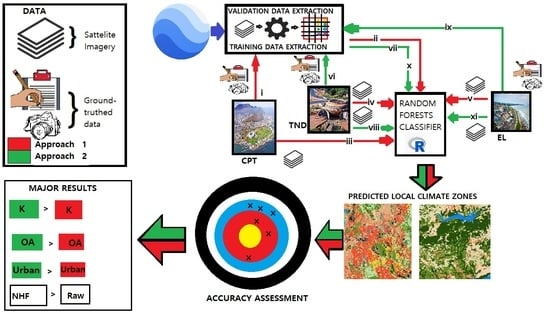Sentinel-Based Adaptation of the Local Climate Zones Framework to a South African Context
Abstract
:1. Introduction
2. Materials and Methods
2.1. Study Area
2.2. Materials and Methods
2.2.1. Sentinel-2 Multispectral Imagery
2.2.2. Definition of LCZ Classification
- i.
- Model TrainingTwo types of model training sets were developed for the classification where the first was standardized and the second was customized to the context of the urban area. The ground reference data were collected initially using digital globe resources due to COVID restrictions and were validated and revised in situ on February and March 2022 in Cape Town, Thohoyandou and East London. Based on a digital globe basemap, circular regions of interest were made using QGIS having a diameter of 100 m following the specifications of the standard typology as outlined by WUDAPT. The field campaign was then used as a manual method to verify the regions of interest (Figure 2). Most (80%) of the regions of interest were used for training and the remaining 20% were used for validation. The field campaign was also used to observe and document the unique elements of each urban region for the discriminations of subclasses to feed into the more specific training for Approach 2.
- a.
- Approach 1The WUDAPT LCZ typology guidelines for the development of training data was applied. These guidelines are divided into subcategories depending on the scale of the total area, classification methods and the intended use of the final product [47]. These guidelines have a strict protocol for training with the objective of using the WUDAPT online LCZ generator as well as a more flexible protocol for developing training data to be used outside the WUDAPT generator [16]. The development of these training polygons depends on a combination of general typology elements such as cover, material, geometry and function taken to different levels of detail depending on the scale of the imagery and the purpose of the classification. Cities are then mapped using the scheme of [15], which classifies the urban landscape into 10 urban and seven natural classes. Each class in the typology represents a LCZ described in terms of specific landscape parameters of mean building height, canyon width, aspect ratio, building surface ratio and impervious area. These training areas are used to characterize the reflectance properties of each LCZ, which is then used to develop a model that assigns every other untrained pixel of the image into the LCZ classes within the framework.A three-step sampling method (Figure 3) was adopted from [52]. This block-based system was developed for LCZ classification at the city block scale primarily as GIS-based. In this study, this method was used to guide the development of training samples following the three steps.The natural city blocks are easier to assign to LCZ classes because they are homogenous, but the urban classes are much harder even with the physical access to the area. Urban LCZ metadata variables were thus limited to mean building height (), which is the number of stories as collected in the field, mean building height (BH), canyon width (CW), aspect ratio, building surface ratio and impervious area (Figure 4). When the number of stories per building is less than 10, every story is assumed to be 3 m; otherwise, Equation (1) is used for buildings with more than 10 stories [53]. Buildings with one to three stories were considered low-rise, four to nine stories were considered mid-rise, and more than nine stories were classified as high rise (Figure 5). Canyon width is estimated by the average distance between two buildings. Aspect ratio is estimated by the ratio of the building height (BH) to the canyon width (W). Building surface fraction (BSF) and impervious surface fraction (ISF) were estimated using simple calculations in QGIS following the polygonization method (Figure 4) for areas of built and impervious surfaces. These variables were all used to assign each one of the blocks into LCZ classes (Figure 5). Within each block, multiple points were placed at a distance of 200 m from each other. A circular buffer of 50 m was created around each point, ultimately becoming the circular LCZ training polygon. Each of these training polygons was at least 100 m from the next one. A total of 200 training polygons were selected for the model training.Building Height (BH) = H_(s) × 3.5 + 9.6 + 2.6 × (H_(s)/25): H_(s)
- b.
- Local Customized Training Input (Approach 2)This approach is developed based on the layout and design of each city taking into account features that are common across all three cities and features that are unique to the specific urban region. In Thohoyandou, the urbanized city center and the immediate blocks around the city center have rural features integrated into the urban landscape. The intra-block streets in Thohoyandou are not homogenous in material; some are asphalted while some are gravel. While in a standard framework, the building density and height stand out as the main discriminators for local climate zones, the street canyon material stands out just as significantly in Thohoyandou. This is also noted by [27], who stated that as a unique general feature, remote African urban areas tend to have more bare soils than western urban. While this might not be statistically significant for a highly urbanized and highly westernized city such as Cape Town, its significance in a small town such as Thohoyandou cannot be neglected without investigation. However, spectrally separating bare soil from impervious surfaces in a remote sensing approach at the level of the pixel (10 m) has inherent confusion in spectral signatures [54]. Therefore, Following Jin’s blocking, a GIS approach was developed in order to create a criterion for separating blocks that are completely asphalted from blocks that are gravel within the urban area without the inherent confusion of a remote sensing approach. A digitization process was applied to digital globe imagery to create asphalted and bare soil inter-street blocks (Figure 6).The output of this digitization was used to separate training inputs that are in gravel blocks from those that are in asphalted blocks. LCZ 3 was the only class observed to be present in both block types. The buildings within LCZ 9 in Thohoyandou are also further apart than they are in Cape Town and East London. The space between houses is thus confused with Shrublands (LCZ 14) due to the dry nature of the shrublands in Thohoyandou. In order to reduce this confusion, the low plants were thus combined with shrubs lands to form a single class. Scattered trees were also combined with dense trees to form a single class. The number of the natural classes was thus minimized so that the built classes can then stand out more spectrally. Impervious surface and bare soil were also combined to form a single class. This is because they are the least represented classes in the area, and combining them makes them a slightly larger class. This thus makes the updated training set for Thohoyandou to become LCZ 3a, 3b, 6, 8, 9, 11 & 12, 13 & 14, 15 & 16, 17.In East London, the ground truthing process in lightweight zones (LCZ 7) revealed a unique class that is a hybrid between lightweight and compact low-rise (Figure 7). A unique feature of South African light weight squatter camps is that they have no designated stand-numbers. This means they have no yards, and it is common for houses to share walls with their neighbors on all sides except the front. Because of this nature of South African squatter camps, the integration of LCZ 3 and LCZ 7 in these East London zones happens below the minimum size of the local climate (100 m). This is thus treated as a unique class and incorporated as LCZ 7a into the updated East London training, which then becomes LCZ 2, 3, 5, 6, 7, 7a, 8, 9, 10, 11, 13, 14, 16, 17.
- ii.
- Remote Sensing Classification ProtocolThe choice of the LCZ classification method is guided by the nature of the data, the available computational resources and the application purpose [45]. The classification protocol was performed via a coded script in R on R-Studio using mainly the CARET package through a Random Forests (RF) classifier. This was designed to extract the training pixels from the image stack, build predictive models that assign the rest of the image pixels into the most fitting class based on surface reflectance values and to validate the assigned pixels. This was performed on a single image stack as well as a multitemporal image stack.
- a.
- Single Image vs. Multitemporal Classification and Neighborhood FunctionThe first classification method is the most straightforward application of a LCZ classification and consists of applying the iterative process on a single date image. The seasonality was therefore analyzed in terms of meteorological seasons, namely winter, spring, summer and autumn, each in turn, by one scene at the center of the season [55]. For the multitemporal approach, accuracies of single-image classifications of each season will therefore be compared with those of a classification combining images of all four seasons. This is in order to account for the spectral and spatial changes in the natural vegetation that is caused by seasonal changes. This has the potential to increase the accuracy of the classification. This eliminates confusing between seasonal classes such as bare soil in the dry period, which is covered by low vegetation in the rainy periods.
- b.
- Neighborhood FunctionA neighborhood function or contextual classifier can contribute to increased accuracies in the classification of urban areas that are internally highly differentiated or heterogeneous, resulting from historical urbanization patterns that reflect the locality and the culture. In addition, most classification methods, including the original WUDAPT protocol, do not take this spatial variation into account. Moreover, the WUDAPT workflow causes a loss of spectral variability information before the actual classification by resampling the Landsat images during the pre-processing phase to a spatial resolution of 100 m [56,57,58,59,60]. At 10 m resolution, the sensitivity of the neighborhood function was tested by increasing the size of the kernel window for an optimal cell number.
- iii.
- ValidationThe ground truth data were randomly split in R into a training (80%) and validation (20%) set. The validation set is used to validate the model using accuracy metrics. The first accuracy metric performed was visual comparison of the output with satellite imagery. The User Accuracy (UA) is the probability that the predicted value is correct; the Producer’s Accuracy (PA) is the probability that a value in a certain class was classified correctly. The Overall Accuracy (OA), the Kappa coefficient, is a measure of the agreement between classification and truth values. All were calculated according to the guidelines in [48]. The F1-score was calculated as the harmonic mean of the UA and PA, which is even more useful when the classes are not balanced.
3. Results
3.1. Local and Remote Standard LCZ Training (Approach 1)
3.1.1. Visual Analysis of the Classification Outputs
3.1.2. Single Versus Multi-Seasonal Images and Neighborhood Functions Comparing Performance of Remote and Local Standard Trainings
3.2. Classification Using Local Customized Training Data (Approach 2)
3.2.1. Thohoyandou Classification
- a.
- Random Splitting of Training Data
- b.
- Single Versus Multi-Seasonal Classification and Comparison with Standard Training
3.2.2. East London Classification
4. Conclusions
Author Contributions
Funding
Data Availability Statement
Acknowledgments
Conflicts of Interest
References
- Adams, R.M. The origin of cities. Sci. Am. 1960, 203, 153–172. [Google Scholar] [CrossRef]
- Robinson, E.; Zahid, H.J.; Codding, B.F.; Haas, R.; Kelly, R.L. Spatiotemporal dynamics of prehistoric human population growth: Radiocarbon ‘dates as data’ and population ecology models. J. Archaeol. Sci. 2019, 101, 63–71. [Google Scholar]
- Pierson, W.A. Spatial Assessment of Urban Growth in Cities of the Decapolis; and the Implications for Modern Cities. Ph.D. Thesis, University of Arkansas, Fayetteville, AR, USA, 2021. [Google Scholar]
- Schaedel, R.P.; Hardoy, J.E.; Scott-Kinzer, N. (Eds.) Urbanization in the Americas from Its Beginning to the Present; Walter de Gruyter: Berlin, Germany, 2011. [Google Scholar]
- Chen, S.; Chen, B.; Feng, K.; Liu, Z.; Fromer, N.; Tan, X.; Alsaedi, A.; Hayat, T.; Weisz, H.; Schellnhuber, H.J.; et al. Physical and virtual carbon metabolism of global cities. Nat. Commun. 2020, 11, 182. [Google Scholar] [CrossRef] [PubMed]
- Balchin, W.G.V.; Pye, N. A micro-climatological investigation of bath and the surrounding district. Q. J. R. Meteorol. Soc. 1947, 73, 297–323. [Google Scholar] [CrossRef]
- Stewart, I.D. Why should urban heat island researchers study history? Urban. Clim. 2019, 30, 100484. [Google Scholar] [CrossRef]
- Lhotka, O.; Kyselý, J.; Farda, A. Climate change scenarios of heat waves in Central Europe and their uncertainties. Theor. Appl. Climatol. 2018, 131, 1043–1054. [Google Scholar] [CrossRef]
- Profiroiu, C.M.; Bodislav, D.A.; Burlacu, S.; Rădulescu, C.V. Challenges of sustainable urban development in the context of population Growth. Eur. J. Sustain. Dev. 2020, 9, 51. [Google Scholar] [CrossRef]
- Al-Thani, H.; Koç, M.; Isaifan, R.J. A review on the direct effect of particulate atmospheric pollution on materials and its mitigation for sustainable cities and societies. Environ. Sci. Pollut. Res. 2018, 25, 27839–27857. [Google Scholar] [CrossRef] [PubMed]
- Longo, S.; Montana, F.; Sanseverino, E.R. A review on optimization and cost-optimal methodologies in low-energy buildings design and environmental considerations. Sustain. Cities Soc. 2019, 45, 87–104. [Google Scholar] [CrossRef]
- Griffith, D.A.; Can, A. Spatial statistical/econometric versions of simple urban population density models. In Practical Handbook of Spatial Statistics; CRC Press: Boca Raton, FL, USA, 2020; pp. 231–249. [Google Scholar]
- Zhou, X.; Okaze, T.; Ren, C.; Cai, M.; Ishida, Y.; Watanabe, H.; Mochida, A. Evaluation of urban heat islands using local climate zones and the influence of sea-land breeze. Sustain. Cities Soc. 2020, 55, 102060. [Google Scholar] [CrossRef]
- Zhou, D.; Xiao, J.; Bonafoni, S.; Berger, C.; Deilami, K.; Zhou, Y.; Frolking, S.; Yao, R.; Qiao, Z.; Sobrino, J.A. Satellite remote sensing of surface urban heat islands: Progress, challenges, and perspectives. Remote Sens. 2019, 11, 48. [Google Scholar] [CrossRef] [Green Version]
- Stewart, I.D.; Oke, T.R. Local climate zones for urban temperature studies. Bull. Am. Meteorol. Soc. 2012, 93, 1879–1900. [Google Scholar] [CrossRef]
- Bechtel, B.; Alexander, P.J.; Böhner, J.; Ching, J.; Conrad, O.; Feddema, J.; Mills, G.; See, L.; Stewart, I. Mapping local climate zones for a worldwide database of the form and function of cities. ISPRS Int. J. Geo-Inf. 2015, 4, 199–219. [Google Scholar] [CrossRef] [Green Version]
- Mushore, T.D.; Mutanga, O.; Odindi, J. Determining the Influence of Long Term Urban Growth on Surface Urban Heat Islands Using Local Climate Zones and Intensity Analysis Techniques. Remote Sens. 2022, 14, 2060. [Google Scholar] [CrossRef]
- Yang, J.; Wang, Y.; Xiu, C.; Xiao, X.; Xia, J.; Jin, C. Optimizing local climate zones to mitigate urban heat island effect in human settlements. J. Clean. Prod. 2020, 275, 123767. [Google Scholar] [CrossRef]
- Zheng, Y.; Ren, C.; Xu, Y.; Wang, R.; Ho, J.; Lau, K.; Ng, E. GIS-based mapping of Local Climate Zone in the high-density city of Hong Kong. Urban. Clim. 2018, 24, 419–448. [Google Scholar] [CrossRef]
- Brousse, O.; Georganos, S.; Demuzere, M.; Vanhuysse, S.; Wouters, H.; Wolff, E.; Linard, C.; Nicole, P.M.; Dujardin, S. Using local climate zones in sub-Saharan Africa to tackle urban health issues. Urban. Clim. 2019, 27, 227–242. [Google Scholar] [CrossRef] [Green Version]
- Engelbrecht, C.J.; Engelbrecht, F.A. Shifts in Köppen-Geiger climate zones over southern Africa in relation to key global temperature goals. Theor. Appl. Climatol. 2016, 123, 247–261. [Google Scholar] [CrossRef]
- Wichmann, J. Heat effects of ambient apparent temperature on all-cause mortality in Cape Town, Durban and Johannesburg, South Africa: 2006–2010. Sci. Total Environ. 2017, 587, 266–272. [Google Scholar] [CrossRef] [Green Version]
- Kiet, A. Arab culture and urban form. Focus 2011, 8, 10. [Google Scholar] [CrossRef] [Green Version]
- Živković, J. Urban form and function. Clim. Action 2020, 862–871. [Google Scholar] [CrossRef]
- Saleh, M.A.E. The impact of Islamic and customary laws on urban form development in southwestern Saudi Arabia. Habitat Int. 1998, 22, 537–556. [Google Scholar] [CrossRef]
- Huang, J.; Lu, X.X.; Sellers, J.M. A global comparative analysis of urban form: Applying spatial metrics and remote sensing. Landsc. Urban Plan. 2007, 82, 184–197. [Google Scholar] [CrossRef]
- Akinyemi, F.O.; Ikanyeng, M.; Muro, J. Land cover change effects on land surface temperature trends in an African urbanizing dryland region. City Environ. Interact. 2019, 4, 100029. [Google Scholar] [CrossRef]
- Wang, R.; Ren, C.; Xu, Y.; Lau, K.K.L.; Shi, Y. Mapping the local climate zones of urban areas by GIS-based and WUDAPT methods: A case study of Hong Kong. Urban Clim. 2018, 24, 567–576. [Google Scholar] [CrossRef]
- Demuzere, M.; Kittner, J.; Bechtel, B. LCZ Generator: A web application to create Local Climate Zone maps. Front. Environ. Sci. 2021, 9, 637455. [Google Scholar] [CrossRef]
- Mushore, T.D.; Dube, T.; Manjowe, M.; Gumindoga, W.; Chemura, A.; Rousta, I.; Odindi, J.; Mutanga, O. Remotely sensed retrieval of Local Climate Zones and their linkages to land surface temperature in Harare metropolitan city, Zimbabwe. Urban Clim. 2019, 27, 259–271. [Google Scholar] [CrossRef]
- Lei, N.; Masanet, E. Climate-and technology-specific PUE and WUE estimations for US data centers using a hybrid statistical and thermodynamics-based approach. Resour. Conserv. Recycl. 2022, 182, 106323. [Google Scholar] [CrossRef]
- Dimitrov, S.; Popov, A.; Iliev, M. Mapping and Assessment of Urban Heat Island Effects in the City of SOFIA, Bulgaria Through Integrated Application of Remote Sensing, Unmanned Aerial Systems (UAS) and GIS. In Proceedings of the Eighth International Conference on Remote Sensing and Geoinformation of the Environment (RSCy2020), Paphos, Cyprus, 16–18 March 2020; International Society for Optics and Photonics: Bellingham, WA, USA, 2020; Volume 11524, p. 115241A. [Google Scholar]
- Zonato, A.; Martilli, A.; Di Sabatino, S.; Zardi, D.; Giovannini, L. Evaluating the performance of a novel WUDAPT averaging technique to define urban morphology with mesoscale models. Urban Clim. 2020, 31, 100584. [Google Scholar] [CrossRef]
- Rodríguez-Carrión, N.M.; Hunt, S.D.; Goenaga-Jimenez, M.A.; Vélez-Reyez, M. June. Determining optimum pixel size for classification. In Algorithms and Technologies for Multispectral, Hyperspectral, and Ultraspectral Imagery XX; International Society for Optics and Photonics: Bellingham, WA, USA, 2014; Volume 9088, p. 90880X. [Google Scholar]
- Pascale, S.; Kapnick, S.B.; Delworth, T.L.; Cooke, W.F. Increasing risk of another Cape Town “Day Zero” drought in the 21st century. Proc. Natl. Acad. Sci. USA 2020, 117, 29495–29503. [Google Scholar] [CrossRef]
- Van der Walt, A.J.; Fitchett, J.M. Statistical classification of South African seasonal divisions on the basis of daily temperature data. S. Afr. J. Sci. 2020, 116, 1–15. [Google Scholar] [CrossRef]
- Chikoore, H.; Bopape, M.J.M.; Ndarana, T.; Muofhe, T.P.; Gijben, M.; Munyai, R.B.; Manyanya, T.C.; Maisha, R. Synoptic structure of a sub-daily extreme precipitation and flood event in Thohoyandou, north-eastern South Africa. Weather Clim. Extrem. 2021, 33, 100327. [Google Scholar] [CrossRef]
- Worden, N.; Van Heyningen, E.; Bickford-Smith, V. Cape Town: The Making of a City: An Illustrated Social History; Uitgeverij Verloren: Hilversum, The Netherlands, 1998. [Google Scholar]
- Bickford-Smith, V. Creating a city of the tourist imagination: The case of Cape Town, The fairest Cape of them all’. Urban. Stud. 2009, 46, 1763–1785. [Google Scholar] [CrossRef]
- Thornberry, E. Rape, Race, and Respectability in a South African Port City: East London, 1870-1927. J. Urban. Hist. 2016, 42, 863–880. [Google Scholar] [CrossRef]
- Hangwelani, H.M.; Lovemore, C. The Impact of Island City in the Post-Apartheid South Africa: Focus on Bantustans. In Proceedings of the Urban Form and Social Context: From Traditions to Newest Demands, Krasnoyarsk, Russia, 5–9 July 2018; pp. 118–128. [Google Scholar]
- Kruger, J. Singing psalms with owls: A Venda twentieth century musical history. Afr. Music. J. Int. Libr. Afr. Music. 1999, 7, 122–146. [Google Scholar] [CrossRef] [Green Version]
- Sykas, D.; Papoutsis, I.; Zografakis, D. Sen4AgriNet: A Harmonized Multi-Country, Multi-Temporal Benchmark Dataset for Agricultural Earth Observation Machine Learning Applications. In Proceedings of the 2021 IEEE International Geoscience and Remote Sensing Symposium IGARSS, Brussels, Belgium, 11–16 July 2021; pp. 5830–5833. [Google Scholar]
- Main-Knorn, M.; Pflug, B.; Louis, J.; Debaecker, V.; Müller-Wilm, U.; Gascon, F. Sen2Cor for sentinel-2. Image Signal Process. Remote Sens. XXIII 2017, 10427, 37–48. [Google Scholar]
- Lillesand, T.; Kiefer, R.W.; Chipman, J. Remote Sensing and Image Interpretation; John Wiley & Sons: New York, NY, USA, 2015. [Google Scholar]
- Sekertekin, A.; Abdikan, S.; Marangoz, A.M. The acquisition of impervious surface area from LANDSAT 8 satellite sensor data using urban indices: A comparative analysis. Environ. Monit. Assess. 2018, 190, 1–13. [Google Scholar] [CrossRef]
- Bechtel, B.; Daneke, C. Classification of local climate zones based on multiple earth observation data. IEEE J. Sel. Top. Appl. Earth Obs. Remote Sens. 2012, 5, 1191–1202. [Google Scholar] [CrossRef]
- Foody, G.M. Status of land cover classification accuracy assessment. Remote Sens. Environ. 2002, 80, 185–201. [Google Scholar] [CrossRef]
- Weih, R.C.; Riggan, N.D. Object-based classification vs. pixel-based classification: Comparative importance of multi-resolution imagery. Int. Arch. Photogramm. Remote Sens. Spat. Inf. Sci. 2010, 38, C7. [Google Scholar]
- Tabi, K.A. Coping with Weather in Cape Town: Use, Adaptation & Challenges in an Informal Settlement. Master’s Thesis, University of the Western Cape, Cape Town, South Africa, 2013. [Google Scholar]
- Plantier, T.; Loureiro, M.; Marques, P.; Caetano, M. Spectral analyses and classification of ikonos images for forest cover characterisation. Cent. Remote Sens. Land Surf. 2006, 28, 260–268. [Google Scholar]
- Jin, L.; Pan, X.; Liu, L.; Liu, L.; Liu, J.; Gao, Y. Block-based local climate zone approach to urban climate maps using the UDC model. Build. Environ. 2020, 186, 107334. [Google Scholar] [CrossRef]
- Abrams, F. Mapping Local Climate Zones with SENTINEL Imagery in Ha Tinh and Hanoi, Vietnam; Katholieke Universiteit Leuven: Leuven, Belgium, 2019. [Google Scholar]
- Mora, C.; Vieira, G.; Pina, P.; Lousada, M.; Christiansen, H.H. Land cover classification using high-resolution aerial photography in adventdalen, Svalbard. Geogr. Ann. Ser. A Phys. Geogr. 2015, 97, 473–488. [Google Scholar] [CrossRef]
- Geletič, J.; Lehnert, M.; Savić, S.; Milošević, D. Inter-/intra-zonal seasonal variability of the surface urban heat island based on local climate zones in three central European cities. Build. Environ. 2019, 156, 21–32. [Google Scholar] [CrossRef]
- Bechtel, B.; Demuzere, M.; Mills, G.; Zhan, W.; Sismanidis, P.; Small, C.; Voogt, J. SUHI analysis using Local Climate Zones—A comparison of 50 cities. Urban. Clim. 2019, 28, 100451. [Google Scholar] [CrossRef]
- Demuzere, M.; Bechtel, B.; Middel, A.; Mills, G. Mapping Europe into local climate zones. PLoS ONE 2019, 14, e0214474. [Google Scholar] [CrossRef] [PubMed] [Green Version]
- Demuzere, M.; Hankey, S.; Mills, G.; Zhang, W.; Lu, T.; Bechtel, B. Combining expert and crowd-sourced training data to map urban form and functions for the continental US. Sci. Data 2020, 7, 264. [Google Scholar] [CrossRef]
- Van damme, S.; Demuzere, M.; Verdonck, M.L.; Zhang, Z.; Van Coillie, F. Revealing kunming’s (china) historical urban planning policies through local climate zones. Remote Sens. 2019, 11, 1731. [Google Scholar] [CrossRef] [Green Version]
- Verdonck, M.L.; Okujeni, A.; van der Linden, S.; Demuzere, M.; De Wulf, R.; Van Coillie, F. Influence of neighbourhood information on ‘Local Climate Zone’ mapping in heterogeneous cities. Int. J. Appl. Earth Obs. Geoinf. 2017, 62, 102–113. [Google Scholar] [CrossRef]
- Keany, E.; Bessardon, G.; Gleeson, E. Using machine learning to produce a cost-effective national building height map of Ireland to categorise local climate zones. Adv. Sci. Res. 2022, 19, 13–27. [Google Scholar] [CrossRef]
- Qiu, C.; Mou, L.; Schmitt, M.; Zhu, X.X. Local climate zone-based urban land cover classification from multi-seasonal Sentinel-2 images with a recurrent residual network. ISPRS J. Photogramm. Remote Sens. 2019, 154, 151–162. [Google Scholar] [CrossRef] [PubMed]
- Kabano, P.; Lindley, S.; Harris, A. Evidence of urban heat island impacts on the vegetation growing season length in a tropical city. Landsc. Urban Plan. 2021, 206, 103989. [Google Scholar] [CrossRef]
- Zhao, W.; Qu, Y.; Zhang, L.; Li, K. Spatial-aware SAR-optical time-series deep integration for crop phenology tracking. Remote Sens. Environ. 2022, 276, 113046. [Google Scholar] [CrossRef]
- Zhou, Y. Understanding urban plant phenology for sustainable cities and planet. Nat. Clim. Chang. 2022, 12, 302–304. [Google Scholar] [CrossRef]
- Cai, M.; Ren, C.; Xu, Y.; Lau, K.K.L.; Wang, R. Investigating the relationship between local climate zone and land surface temperature using an improved WUDAPT methodology—A case study of Yangtze River Delta, China. Urban. Clim. 2018, 24, 485–502. [Google Scholar] [CrossRef]
- Shi, L.; Ling, F.; Foody, G.M.; Yang, Z.; Liu, X.; Du, Y. Seasonal SUHI Analysis Using Local Climate Zone Classification: A Case Study of Wuhan, China. Int. J. Environ. Res. Public Health 2021, 18, 7242. [Google Scholar] [CrossRef]
- Rosentreter, J.; Hagensieker, R.; Waske, B. Towards large-scale mapping of local climate zones using multitemporal Sentinel 2 data and convolutional neural networks. Remote Sens. Environ. 2020, 237, 111472. [Google Scholar] [CrossRef]
- Yoo, C.; Han, D.; Im, J.; Bechtel, B. Comparison between convolutional neural networks and random forest for local climate zone classification in mega urban areas using Landsat images. ISPRS J. Photogramm. Remote Sens. 2019, 157, 155–170. [Google Scholar] [CrossRef]
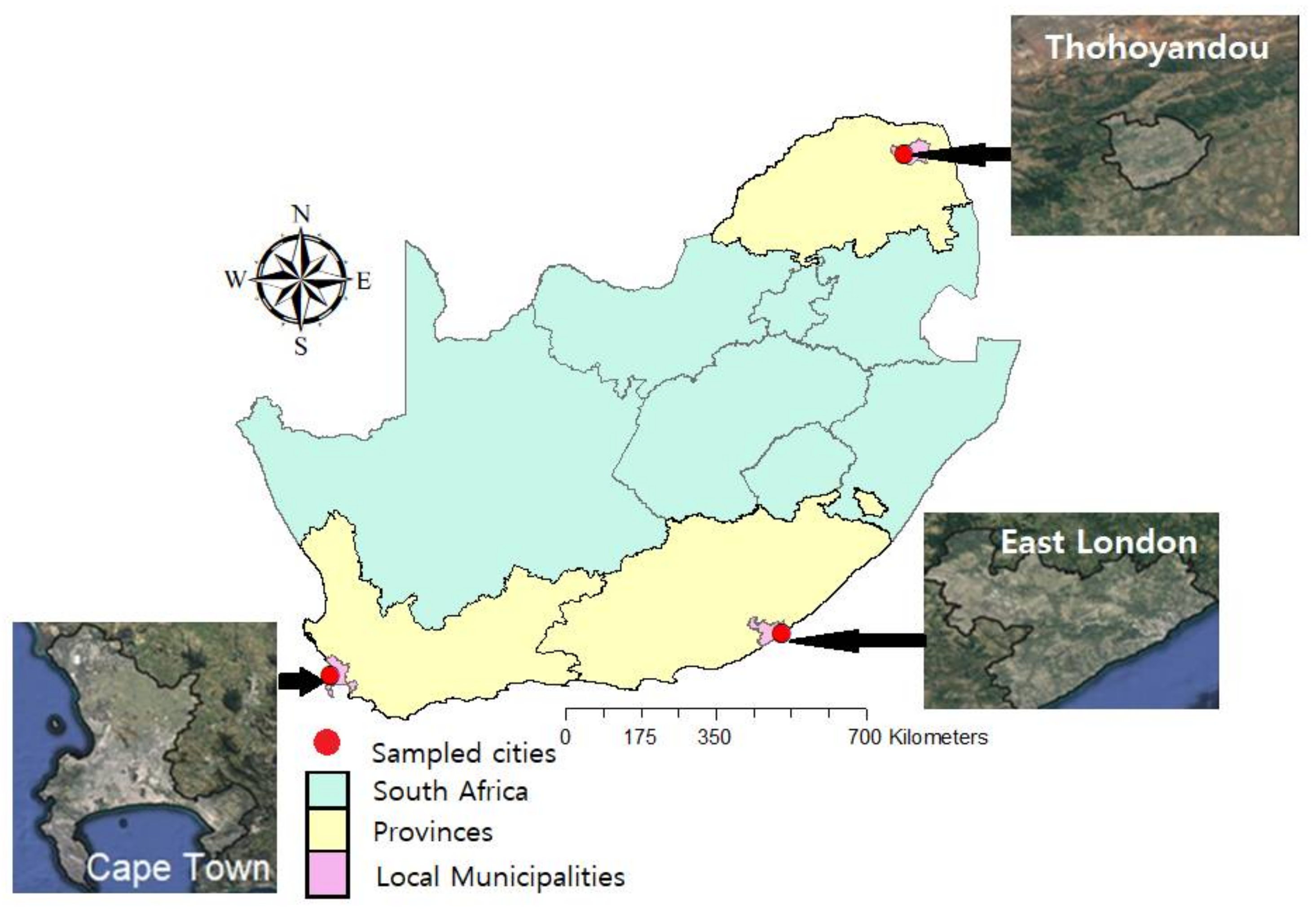
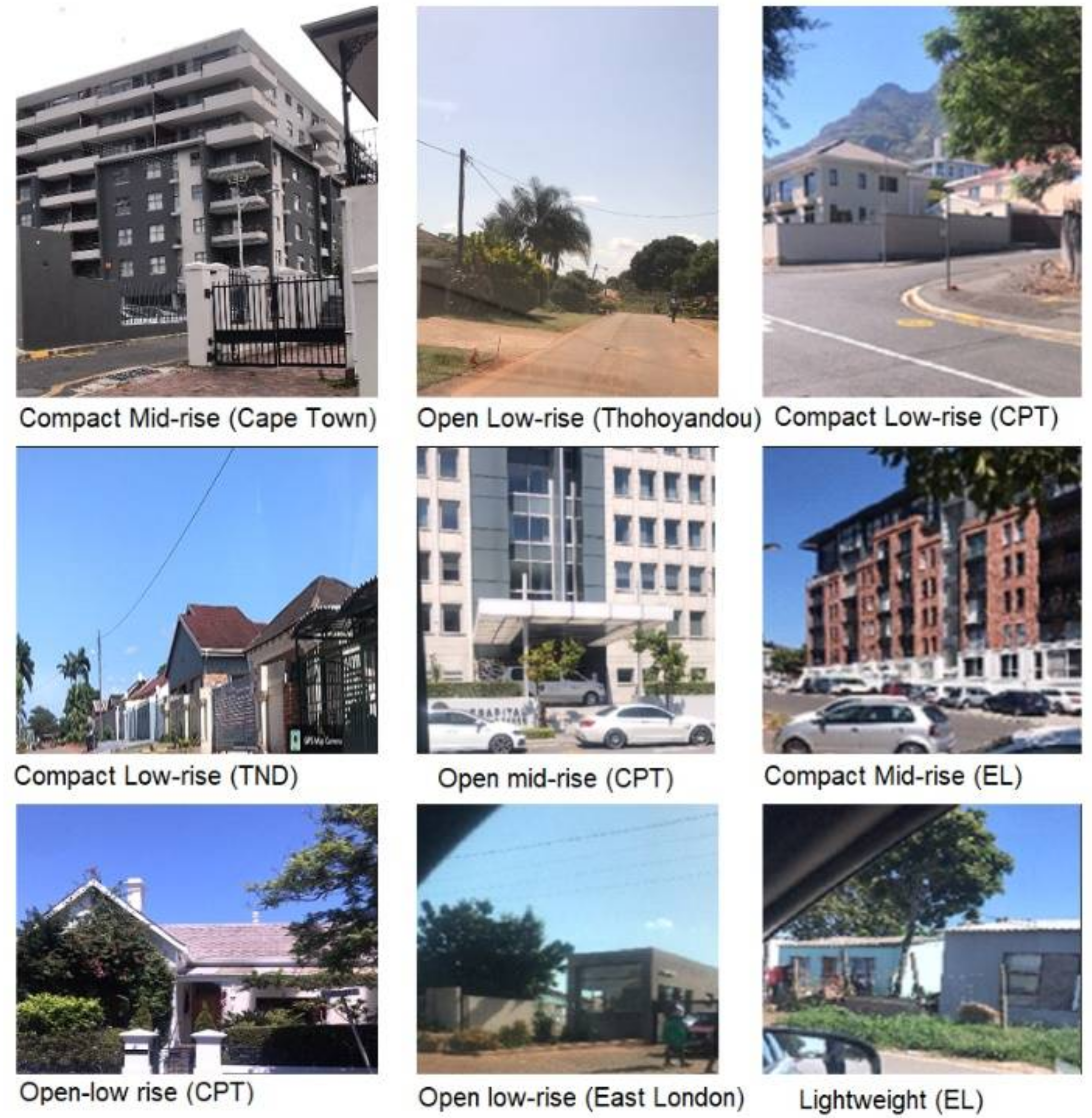

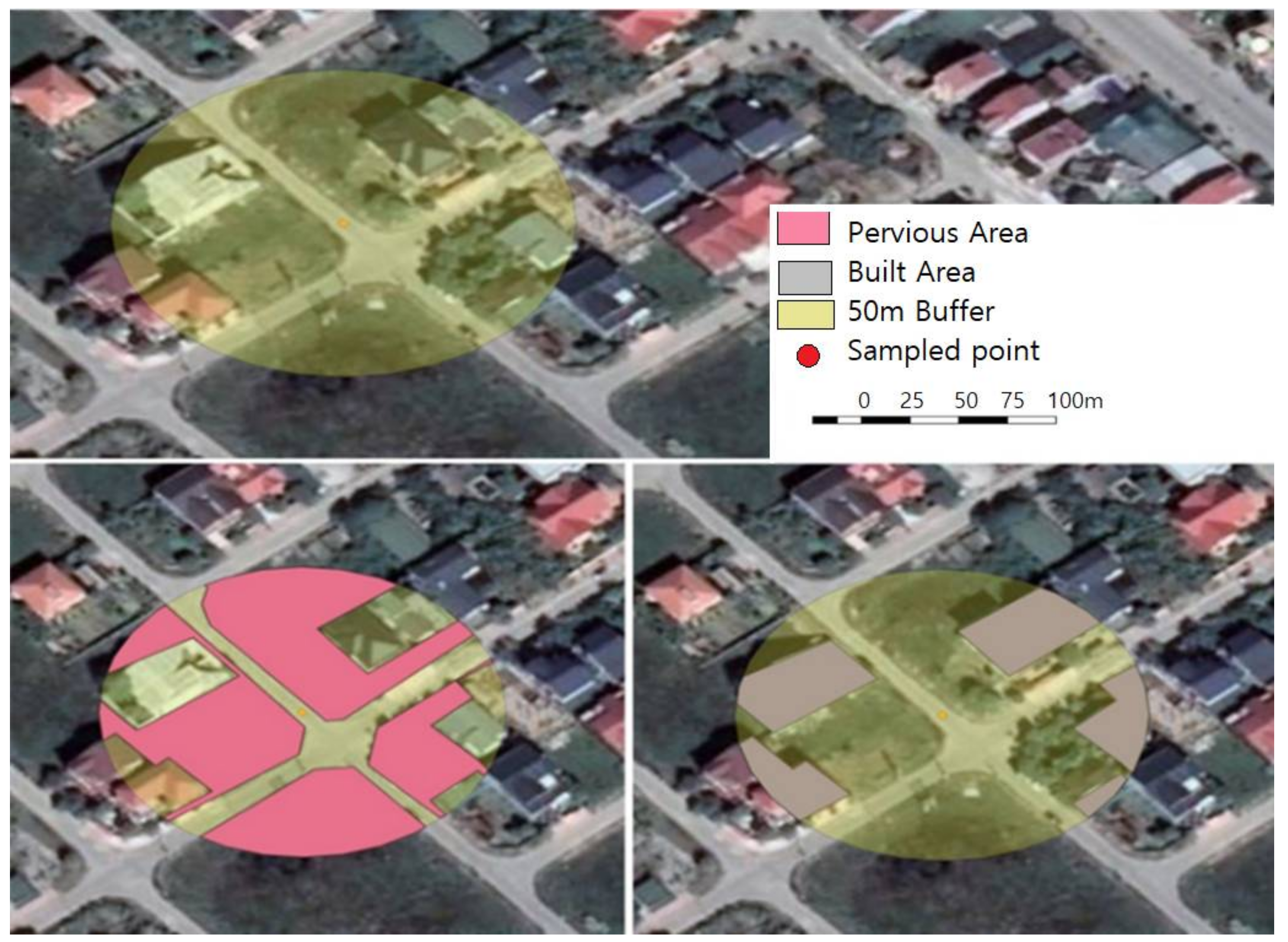

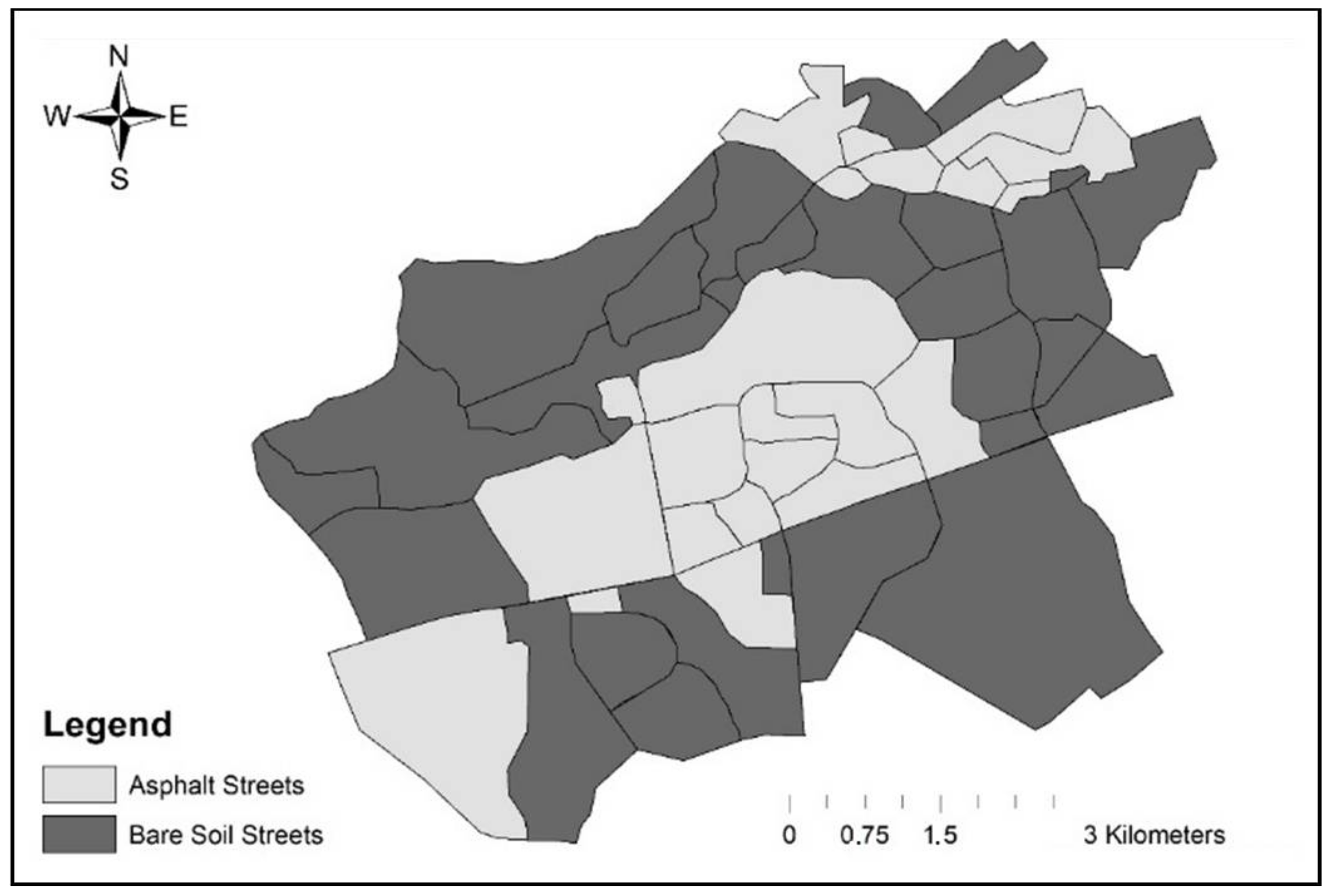

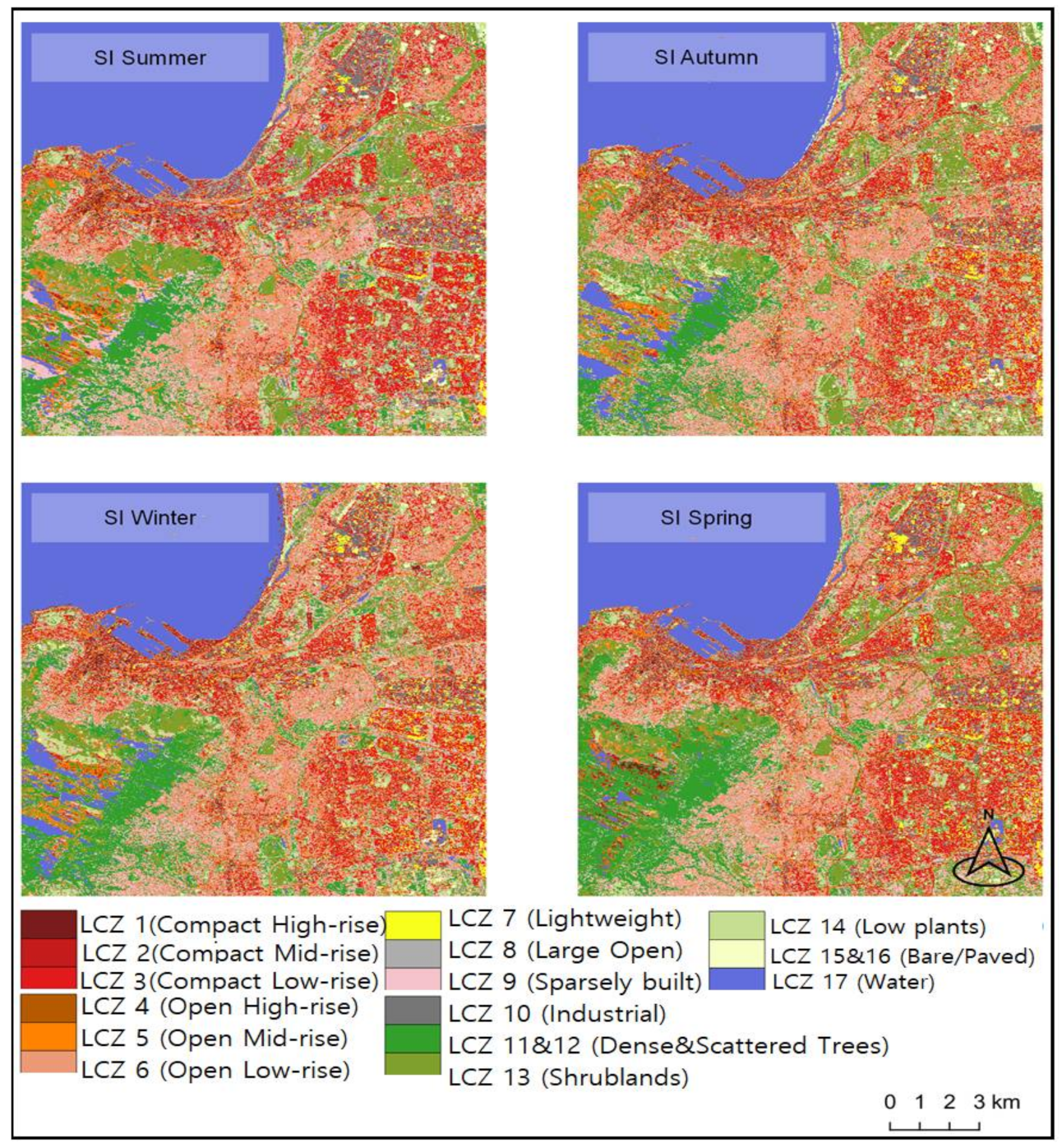

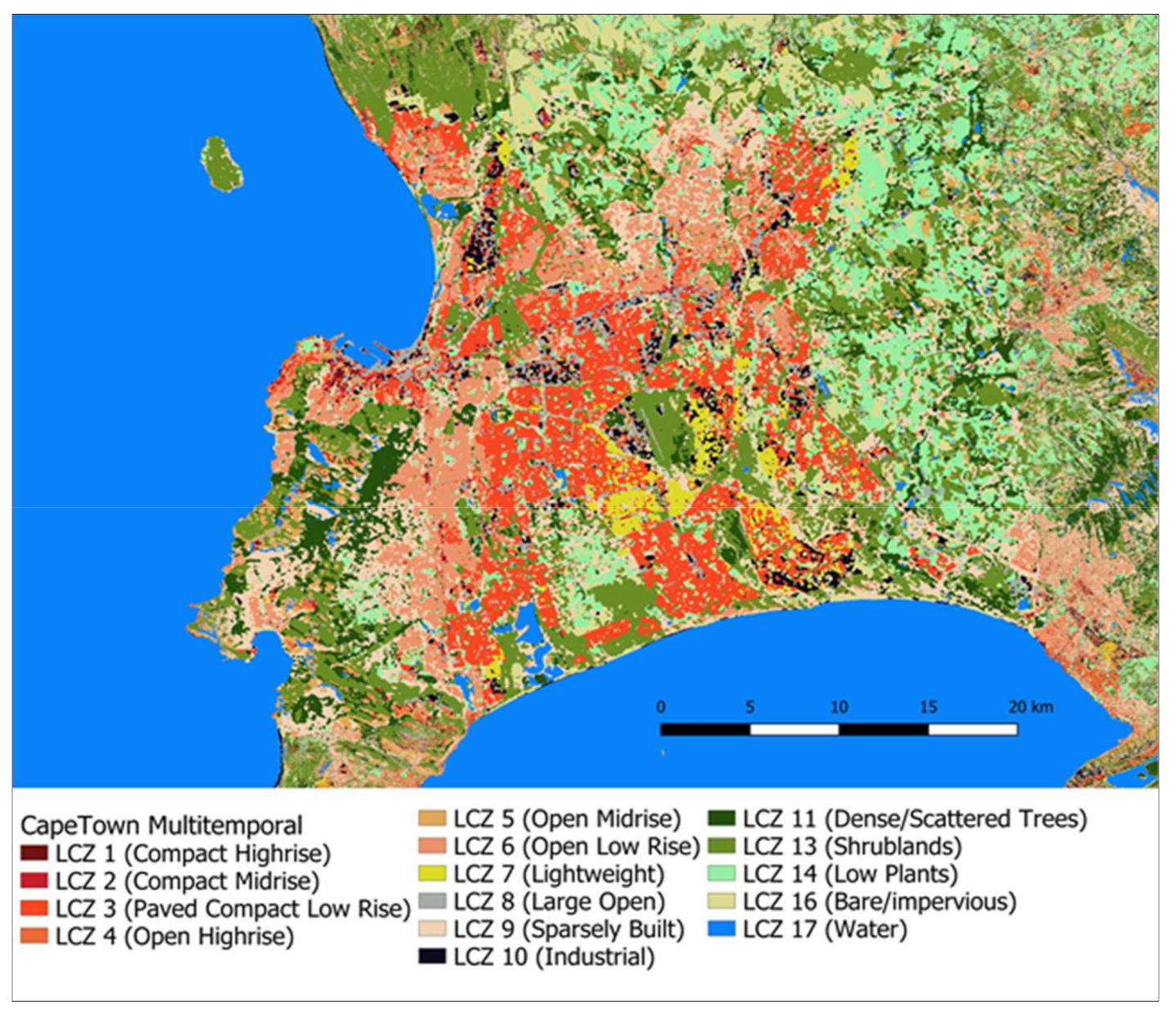

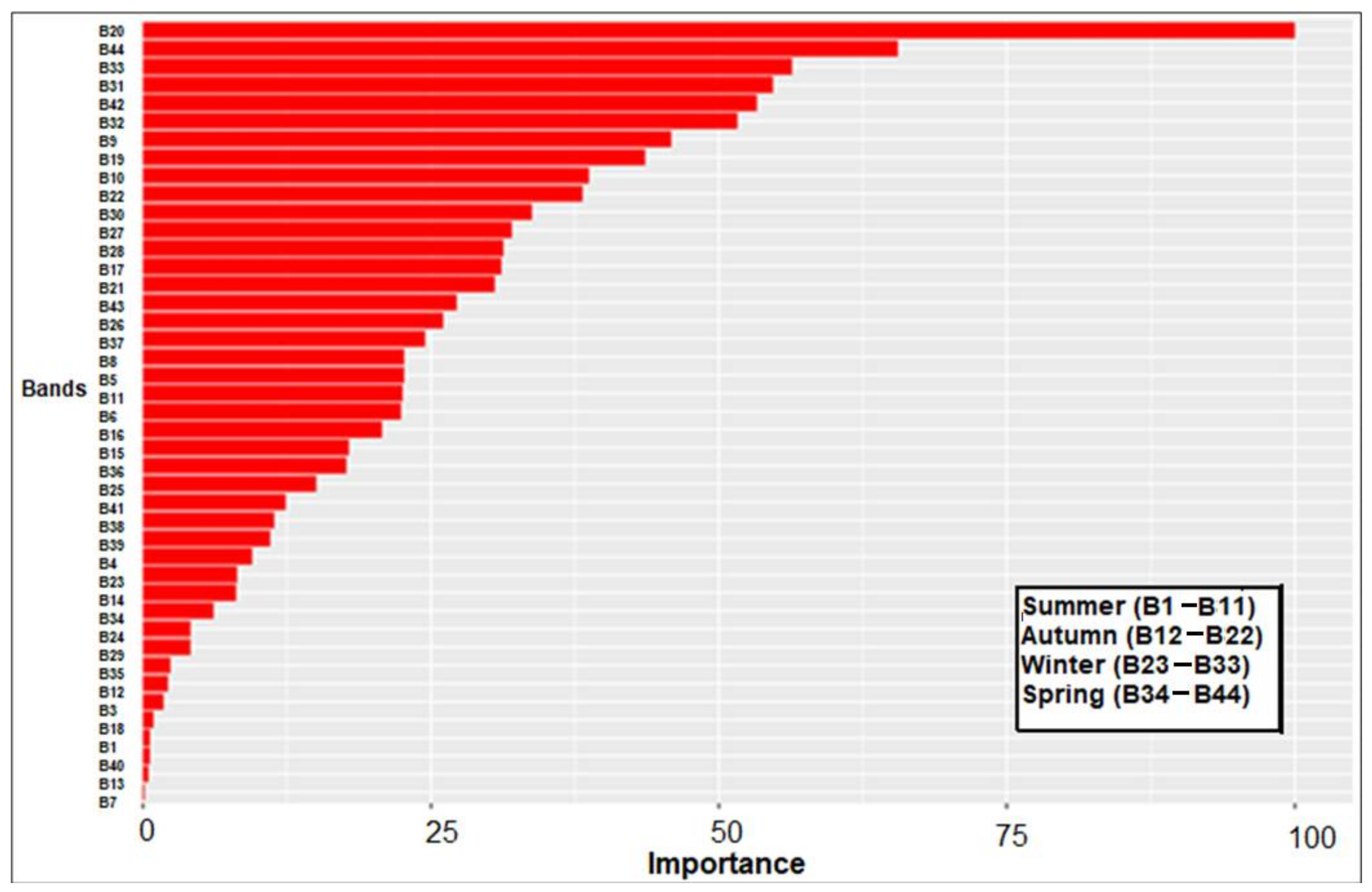
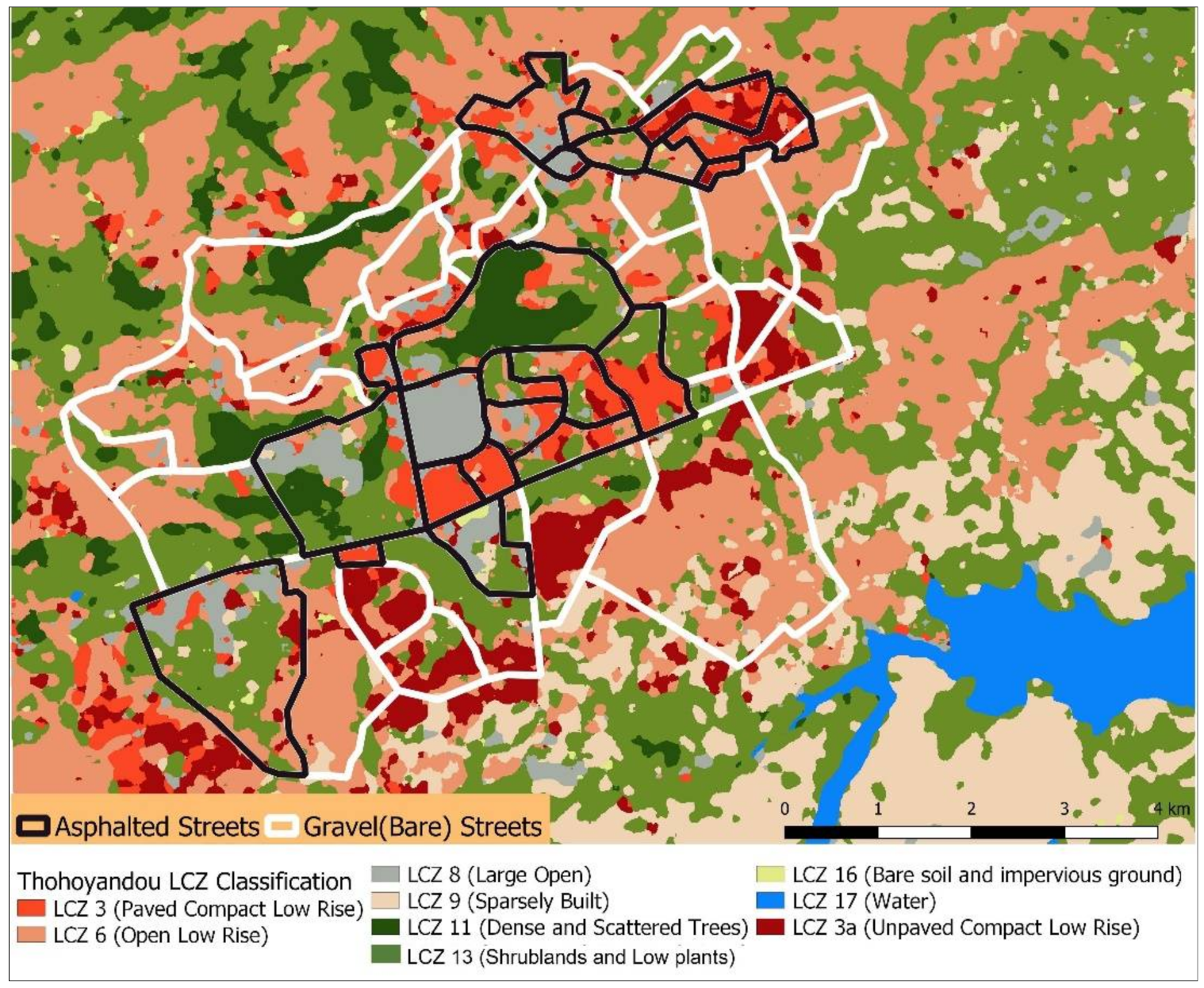
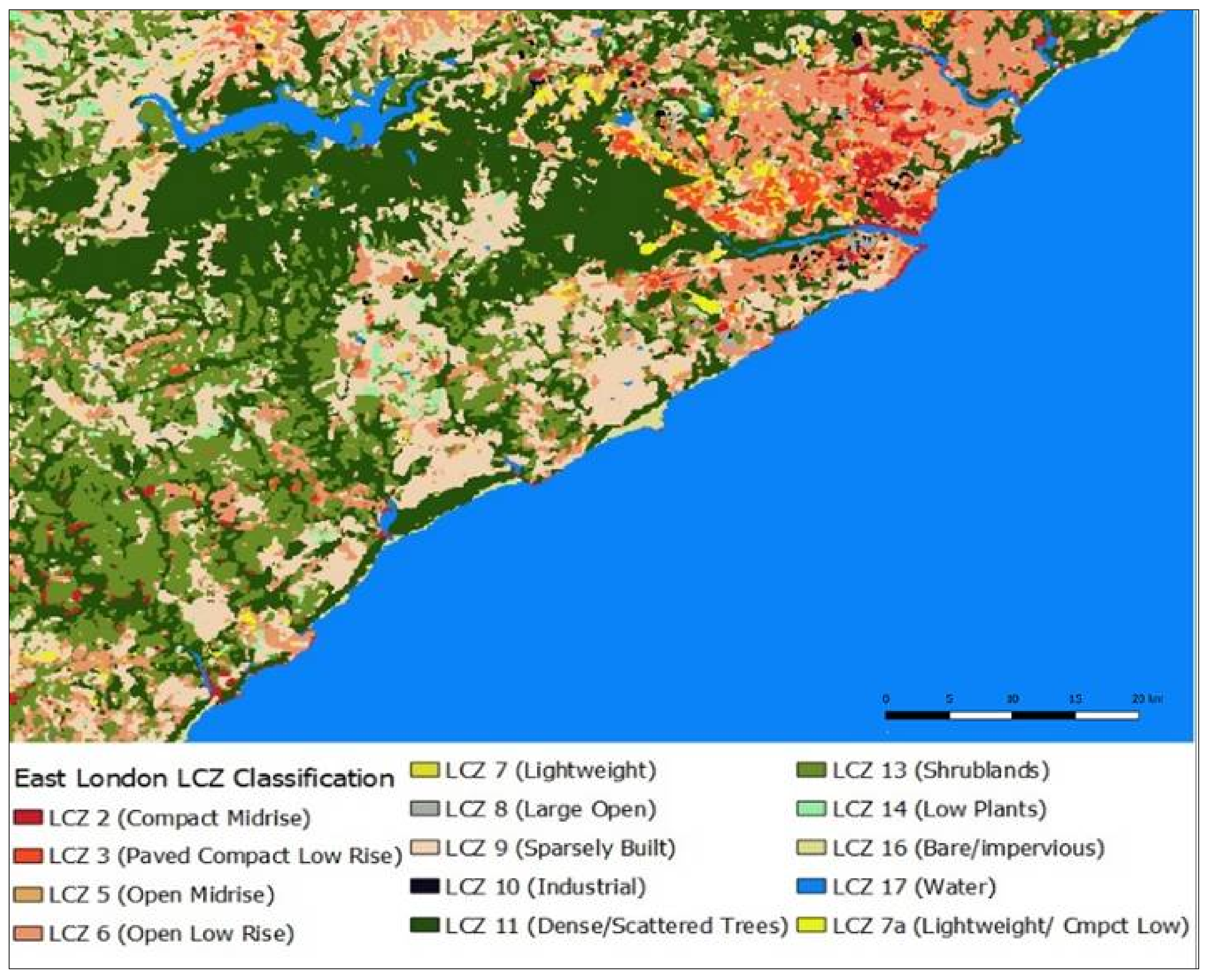
| Sentinel-2 | ||||
|---|---|---|---|---|
| Summer | Autumn | Winter | Spring | |
| Cape Town | 25 February 2018 | 16 May 2018 | 24 August 2018 | 2 November 2018 |
| East London | 7 January 2018 | 28 March 2018 | 6 July 2018 | 14 September 2018 |
| Thohoyandou | 13 December 2018 | 27 April 2018 | 26 July 2018 | 24 September 2018 |
| Metrics | SI Summer | SI Autumn | SI Winter | SI Spring | Multitemporal |
|---|---|---|---|---|---|
| OA | 36.20% | 40.10% | 41.80% | 42.70% | 44.10% |
| OA-urb | 29.80% | 28.70% | 31.80% | 32.70% | 33.80% |
| OA-nat | 47.20% | 68.20% | 64.30% | 63.90% | 68.50% |
| Kappa | 31.20% | 35.50% | 37.20% | 38.00% | 39.60% |
| F1–metric | 36.50% | 40.40% | 42.60% | 43.20% | 45.20% |
| Classified | Reference Classes | User’s Accuracy | ||||||||||||||
|---|---|---|---|---|---|---|---|---|---|---|---|---|---|---|---|---|
| 1 | 2 | 3 | 4 | 5 | 6 | 7 | 8 | 9 | 10 | 11 | 13 | 14 | 16 | 17 | ||
| 1 | 42 | 15 | 0 | 10 | 8 | 2 | 0 | 63 | 0 | 9 | 0 | 0 | 7 | 0 | 0 | 27% |
| 2 | 27 | 120 | 17 | 61 | 71 | 19 | 41 | 87 | 6 | 44 | 7 | 1 | 9 | 0 | 0 | 24% |
| 3 | 55 | 156 | 506 | 77 | 146 | 326 | 213 | 155 | 55 | 58 | 0 | 0 | 4 | 0 | 0 | 29% |
| 4 | 16 | 46 | 7 | 67 | 96 | 33 | 2 | 46 | 26 | 26 | 6 | 33 | 13 | 2 | 1 | 16% |
| 5 | 43 | 100 | 26 | 82 | 118 | 22 | 22 | 63 | 58 | 13 | 11 | 9 | 54 | 0 | 8 | 19% |
| 6 | 80 | 166 | 75 | 171 | 195 | 352 | 0 | 1 | 315 | 6 | 59 | 59 | 4 | 4 | 0 | 24% |
| 7 | 1 | 46 | 438 | 11 | 5 | 120 | 847 | 103 | 65 | 46 | 0 | 7 | 5 | 0 | 0 | 50% |
| 8 | 53 | 107 | 42 | 48 | 66 | 64 | 107 | 247 | 34 | 116 | 0 | 6 | 13 | 0 | 0 | 27% |
| 9 | 27 | 45 | 82 | 66 | 124 | 180 | 50 | 40 | 462 | 28 | 134 | 229 | 13 | 38 | 0 | 30% |
| 10 | 37 | 34 | 32 | 41 | 57 | 9 | 100 | 218 | 15 | 607 | 0 | 0 | 0 | 99 | 0 | 49% |
| 11 | 3 | 1 | 0 | 25 | 37 | 3 | 1 | 2 | 64 | 0 | 763 | 147 | 88 | 3 | 82 | 63% |
| 13 | 3 | 12 | 27 | 24 | 11 | 46 | 41 | 27 | 106 | 124 | 30 | 702 | 254 | 30 | 0 | 49% |
| 14 | 0 | 6 | 2 | 5 | 9 | 0 | 0 | 22 | 104 | 1 | 0 | 30 | 429 | 0 | 0 | 71% |
| 16 | 0 | 3 | 1 | 9 | 0 | 5 | 65 | 25 | 36 | 17 | 0 | 23 | 130 | 293 | 0 | 48% |
| 17 | 0 | 0 | 0 | 0 | 0 | 0 | 0 | 0 | 0 | 0 | 0 | 0 | 0 | 78 | 929 | 92% |
| Producer’s Accuracy | 11% | 14% | 40% | 10% | 13% | 30% | 57% | 22% | 34% | 55% | 76% | 56% | 42% | 54% | 91% | Overall Accuracy |
| 43% | ||||||||||||||||
| SI | SI + NH | MT | MT + NH | |||||
|---|---|---|---|---|---|---|---|---|
| Kernel Size | / | 11 × 11 | 13 × 13 | 15 × 15 | / | 11 × 11 | 13 × 13 | 15 × 15 |
| OA | 42.70% | 48.50% | 48.70% | 48.40% | 44.10% | 49.10% | 49.80% | 49.50% |
| OA-urb/nat | 88.80% | 91.30% | 91.00% | 90.50% | 87.70% | 89.70% | 89.40% | 89.00% |
| OA-urb | 32.70% | 37.10% | 37.50% | 37.00% | 33.80% | 38.50% | 39.40% | 39.40% |
| OA-nat | 63.90% | 72.70% | 72.70% | 72.70% | 68.50% | 71.70% | 71.80% | 71.20% |
| Kappa | 38.00% | 44.10% | 44.40% | 44.10% | 39.60% | 44.90% | 45.60% | 45.40% |
| F1–metric | 43.20% | 49.20% | 49.40% | 49.10% | 45.20% | 50.10% | 50.90% | 50.70% |
| CPT | Thohoyandou | East London | ||||||||
|---|---|---|---|---|---|---|---|---|---|---|
| Training | Local | Remote | Local | Remote | Local | |||||
| Stack | SI | MT | SI | MT | SI | MT | SI | MT | SI | MT |
| OA | 48.70% | 49.80% | 31.40% | 53.20% | 54.8186 | 60.50% | 39.10% | 41.30% | 40.70% | 43.40% |
| OA-urb/nat | 91.00% | 89.40% | 72.90% | 81.50% | 81.00% | 86.20% | 91.70% | 85.50% | 89.00% | 84.30% |
| OA-urb | 37.50% | 39.40% | 16.80% | 37.40% | 31.00% | 34.00% | 22.90% | 26.10% | 34.60% | 42.10% |
| OA-nat | 72.70% | 71.80% | 41.80% | 94.00% | 75.00% | 80.70% | 61.90% | 72.70% | 79.10% | 80.60% |
| Kappa | 44.40% | 45.60% | 22.10% | 45.50% | 45.7 | 55.30% | 33.30% | 35.70% | 35.10% | 37.60% |
| F1–metric | 49.40% | 50.90% | 24.00% | 53.50% | 53.10% | 56.30% | 33.50% | 38.40% | 33.90% | 40.10% |
| Summer | Autumn | Winter | Spring | Multitemporal | ||||||
|---|---|---|---|---|---|---|---|---|---|---|
| Raw | NF | Raw | NF | Raw | NF | Raw | NF | Raw | NF | |
| OA | 60.64 | 71.74 | 54.92 | 71.36 | 58.25 | 71.8 | 59.15 | 73.42 | 73.92 | 82.68 |
| OA-nat | 81.65 | 87.36 | 79.1 | 87.44 | 85.06 | 87.83 | 80.61 | 85.54 | 83.65 | 88.58 |
| OA-urb | 43.44 | 62.11 | 40.92 | 55.06 | 42.01 | 58.61 | 47.11 | 63.49 | 53.2 | 69.66 |
| Kappa | 53.12 | 65.19 | 46.08 | 64.58 | 50.4 | 65.69 | 51.83 | 67.5 | 70.31 | 75.6 |
| F1 score | 0.554 | 0.65 | 0.5324 | 0.627 | 0.5513 | 0.661 | 0.5766 | 0.694 | 0.695 | 0.764 |
| Classified | Reference | User’s Accuracy | |||||||||
|---|---|---|---|---|---|---|---|---|---|---|---|
| 3 | 6 | 8 | 9 | 11 | 13 | 16 | 17 | 3a | Total | ||
| 3 | 738 | 0 | 29 | 0 | 0 | 0 | 17 | 0 | 33 | 817 | 90% |
| 6 | 47 | 1284 | 1 | 0 | 0 | 186 | 113 | 0 | 110 | 1741 | 74% |
| 8 | 85 | 0 | 1138 | 0 | 0 | 156 | 258 | 0 | 0 | 1637 | 70% |
| 9 | 0 | 0 | 0 | 900 | 0 | 131 | 0 | 0 | 0 | 1031 | 87% |
| 11 | 0 | 0 | 0 | 0 | 943 | 0 | 29 | 0 | 0 | 972 | 97% |
| 13 | 42 | 11 | 4 | 0 | 57 | 1416 | 256 | 0 | 0 | 1786 | 79% |
| 16 | 0 | 0 | 106 | 0 | 0 | 42 | 27 | 0 | 0 | 175 | 15% |
| 17 | 0 | 0 | 0 | 0 | 0 | 0 | 0 | 1800 | 0 | 1800 | 100% |
| 3a | 188 | 5 | 22 | 0 | 0 | 0 | 0 | 0 | 957 | 1172 | 82% |
| Total | 1100 | 1300 | 1300 | 900 | 1000 | 1931 | 700 | 1800 | 1100 | 11,131 | |
| Producer’s Accuracy | 67% | 99% | 88% | 100% | 94% | 73% | 4% | 100% | 87% | Overall Accuracy 82.7% | |
| Summer | Autumn | Winter | Spring | Multitemporal | ||||||
|---|---|---|---|---|---|---|---|---|---|---|
| CLASS KAPPA | Raw | NH | Raw | NH | Raw | NH | Raw | NH | Raw | NH |
| LCZ 2 | 0.216 | 0.238 | 0.422 | 0.425 | 0.443 | 0.457 | 0.453 | 0.456 | 0.436 | 0.465 |
| LCZ 3 | 0.331 | 0.373 | 0.364 | 0.586 | 0.295 | 0.489 | 0.236 | 0.497 | 0.325 | 0.454 |
| LCZ 5 | 0.136 | 0.009 | 0.130 | −0.008 | 0.161 | 0.020 | 0.152 | 0.030 | 0.135 | 0.065 |
| LCZ 6 | 0.299 | 0.419 | 0.340 | 0.369 | 0.295 | 0.456 | 0.296 | 0.456 | 0.350 | 0.440 |
| LCZ 7 | 0.267 | 0.504 | 0.391 | 0.991 | 0.381 | 0.873 | 0.381 | 0.877 | 0.455 | 0.749 |
| LCZ 8 | 0.555 | 0.653 | 0.513 | 0.612 | 0.503 | 0.659 | 0.502 | 0.661 | 0.458 | 0.516 |
| LCZ 9 | 0.346 | 0.410 | 0.300 | 0.372 | 0.264 | 0.356 | 0.255 | 0.356 | 0.350 | 0.408 |
| LCZ 10 | 0.076 | 0.157 | 0.149 | −0.003 | 0.154 | −0.006 | 0.157 | −0.006 | 0.147 | −0.005 |
| LCZ 11 | 0.837 | 0.690 | 0.856 | 0.784 | 0.848 | 0.765 | 0.838 | 0.765 | 0.853 | 0.728 |
| LCZ 13 | 0.417 | 0.598 | 0.430 | 0.665 | 0.289 | 0.631 | 0.275 | 0.631 | 0.763 | 0.936 |
| LCZ 14 | 0.125 | nan | 0.145 | nan | 0.524 | 1.000 | 0.512 | 1.000 | −0.070 | nan |
| LCZ 16 | 1.000 | 1.000 | 0.989 | 1.000 | 1.000 | 1.000 | 1.000 | 1.000 | 0.988 | 1.000 |
| LCZ 17 | 0.997 | 1.000 | 0.964 | 0.959 | 0.922 | 0.873 | 0.832 | 0.873 | 0.972 | 1.000 |
| LCZ 18 | 0.435 | 0.739 | 0.395 | 0.434 | 0.387 | 0.560 | 0.335 | 0.558 | 0.468 | 0.651 |
| MAIN KAPPA | 0.431 | 0.522 | 0.456 | 0.553 | 0.462 | 0.581 | 0.445 | 0.582 | 0.474 | 0.570 |
| OA | 45.951 | 53.530 | 48.305 | 56.528 | 46.736 | 58.401 | 46.723 | 58.553 | 50.240 | 58.540 |
| F1 | 0.444 | 0.497 | 0.465 | 0.525 | 0.467 | 0.565 | 0.462 | 0.567 | 0.481 | 0.538 |
| OA-urb/nat | 76.800 | 76.500 | 68.000 | 75.600 | 76.700 | 75.600 | 76.700 | 75.600 | 77.200 | 76.300 |
Publisher’s Note: MDPI stays neutral with regard to jurisdictional claims in published maps and institutional affiliations. |
© 2022 by the authors. Licensee MDPI, Basel, Switzerland. This article is an open access article distributed under the terms and conditions of the Creative Commons Attribution (CC BY) license (https://creativecommons.org/licenses/by/4.0/).
Share and Cite
Manyanya, T.; Teerlinck, J.; Somers, B.; Verbist, B.; Nethengwe, N. Sentinel-Based Adaptation of the Local Climate Zones Framework to a South African Context. Remote Sens. 2022, 14, 3594. https://doi.org/10.3390/rs14153594
Manyanya T, Teerlinck J, Somers B, Verbist B, Nethengwe N. Sentinel-Based Adaptation of the Local Climate Zones Framework to a South African Context. Remote Sensing. 2022; 14(15):3594. https://doi.org/10.3390/rs14153594
Chicago/Turabian StyleManyanya, Tshilidzi, Janne Teerlinck, Ben Somers, Bruno Verbist, and Nthaduleni Nethengwe. 2022. "Sentinel-Based Adaptation of the Local Climate Zones Framework to a South African Context" Remote Sensing 14, no. 15: 3594. https://doi.org/10.3390/rs14153594







